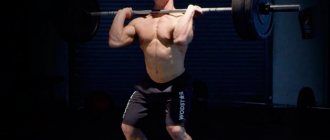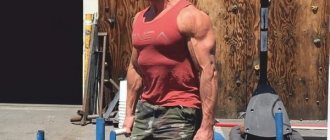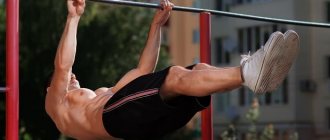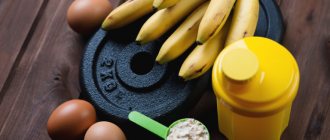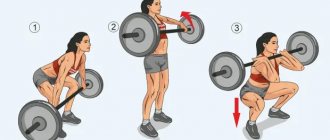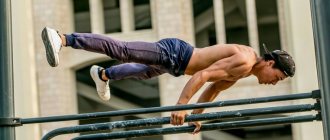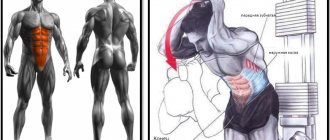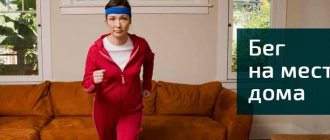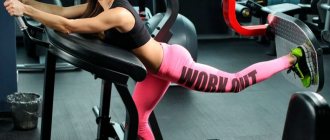Building calves is a difficult task. They consist of the gastrocnemius and soleus muscles, and both groups are in constant motion. These muscles work when walking, running, and rising on your toes. They are constantly involved. We cannot exclude them from working in everyday life. Therefore, the gastrocnemius and soleus are strong and resilient. Often their development is a big problem. Training in a machine is more promising than with a free barbell when it comes to beginners, as well as professional athletes who perform a large volume of training load. Using a machine helps minimize the risk of injury and actually push you to muscle failure.
Load distribution
The calf press belongs to the group of isolation exercises. Movement occurs in only one joint—the ankle. The exercise allows you to concentrate the load as much as possible in the lower leg muscles.
Just as you train your abs, your calves should be trained until you feel a strong burning sensation and so-called failure. It occurs quite quickly due to the fact that the calves are a small muscle group and experience significant tension during training.
If we talk about load distribution in more detail, the platform toe press develops:
- calf muscles - make up the main volume of the lower leg and give it a characteristic relief;
- soleus muscles - located inside under the gastrocnemius.
Core stabilization is not required for the toe press. Apart from the lower leg muscles, other muscles are practically not involved in the movement.
Is it really difficult to pump up calves?
Triceps surae consists of B. J. Schoenfeld, A.D. Vigotsky, J. Grgic. Do the anatomical and physiological properties of a muscle determine its adaptive response to different loading protocols? / Physiological reports mainly from white muscle fibers of the first type, which contract slowly, but can withstand prolonged loads.
To increase the size of your calves, you first need to properly fatigue them, and this is not so easy to do with such durable muscles. In one study, T. C. Chen, Tsung‑Jen Yang 1, Min‑Jyue Huang Damage and the repeated bout effect of arm, leg, and trunk muscles induced by eccentric resistance exercises / Scandinavian journal of medicine and science in sports found that the triceps calf is the least damaged other muscles with the exception of the quadriceps, and recovers faster.
Thus, you will have to work hard to properly load your calves and provide them with the necessary stimulus for growth.
Pros of exercise
The main advantage of the bench press is that it does not overload the lower back at all. Whatever weight you choose, your back will not receive traumatic stress. For this reason, the exercise can be performed even by people with spinal problems. However, if you have previously suffered a serious injury, it is better to consult your doctor first.
With regular exercise you get:
- Dense relief muscles of the lower leg, a clear division of the muscles into 2 heads.
- Increased muscle mass and decreased fat in the calf area.
- Increasing the elasticity of the Achilles tendons, which serves as the prevention of injuries.
- Improving positional stability when squatting with a barbell, improving jumping results and performance in sports games.
Execution technique
First, you need to take the correct position in the simulator. Sit so that your back and lower back are pressed tightly against his back. Place your toes on the edge of the movable platform, while your heels remain free.
Now you can start the exercise:
- Exhale and push the platform away from you with your toes, straightening your ankle as much as possible.
- At the top point of the amplitude, take a short pause for 1 breathing cycle.
- Inhale and return to the starting position, lowering your toes as low as possible and stretching your calves as much as possible. This is 1 repetition.
Complete the required number of repetitions. On average, you need to do 3-4 sets of 15-20 repetitions.
The peculiarity of the toe press is that it must be done in a multi-repetition mode. The more repetitions you do, the better. Do the exercise until you feel an unbearable burning sensation in your muscles.
As an alternative to the leg press machine, you can use a Smith machine. The mechanics of the movement remain the same, only you lie with your back on the floor and press the barbell with your toes.
Platform toe press
Calf raises in the leg press machine are a targeted isolation exercise designed to develop the lower leg muscles, which will allow you to diversify your calf training and reduce the harmful effects on the spine.
Execution technique
Initial position:
- Equip the machine with the optimal weight for you and set the backrest at an angle of 90° to the seat.
- Take your starting position on the seat, pressing your back and buttocks tightly against the support, and grab the handrails on the end sides of the machine with your hands.
- Place your feet on the bottom edge of the movable platform so that only the “toe” part of the foot is engaged, and the heels remain suspended.
- Place your feet in a neutral position, hip-width apart.
- Press the platform up onto straight legs.
- Take the weight of the weight on your toes and lower your heels below the plane of support, stretching the muscles of the lower leg.
Movement:
- From this position, as you exhale, with a controlled movement, press the platform up with your toes, straightening your ankle.
- Hold at the point of maximum muscle contraction for 2 seconds.
- Slowly return to the starting position, bringing your heels behind the platform.
- Complete the planned number of repetitions.
Attention!
- Do not lift your pelvis and back from the seat. Lack of tight contact of the upper part of the body with the support can cause injury to the lumbar region.
- Do not remove the safety stops. The specificity of foot placement increases the likelihood of the foot “slipping” from the supporting platform - the presence of clamps prevents the weight from falling on the athlete.
- Don't push your knees in when performing presses. In this case, traumatic stress is placed on the elements of the joint.
- Do not make sudden or “high-speed” movements. With this style of work, the ankle ligaments are subjected to traumatic stress, which can lead to sprain.
Recommendations!
- To stabilize a safe body position, firmly hold the side handles of the machine with your hands.
- Work in an expanded amplitude, trying to lift your heels as far as possible above the press platform in the highest position and bring them beyond the plane in the negative phase.
- For better “adhesion” to the surface of the simulator pad, perform the exercise in shoes with rough rubberized soles.
- Maintain a moderate speed of movement and control muscle efforts to ensure a high training effect and safety from injury.
Exercise option
- Single leg platform press. In terms of biomechanics, the exercise completely imitates the basic movement with the difference that only one working leg takes the load. This version of the presses allows you to increase the intensity of working out the calf muscles and optimize the neuromuscular connection due to the intense concentration on the movement.
- Leg press with the knee joint bent. A modification of the exercise involves performing the movement with the legs stably bent at the knee joint (angle 90-100°). This allows you to redirect the load vector from the calf muscles to the soleus. The movement is more complex compared to the classic version, since the static load on the quadriceps muscle increases.
Video Toe Press
Video Platform toe press for girls
Analysis of the exercise
The toe press is an isolating exercise, unique in its biomechanical nature, that puts a “pressing” load on the muscles of the legs. The functional “equipment” in this case is a leg press machine.
The main work is performed by the combined effort of the following muscles:
- Medial and lateral head of the gastrocnemius muscles;
- Soleus muscles.
- Additionally, the thigh muscles are statically involved.
Preparing for the exercise
Perform a short general warm-up, focusing on increasing mobility and warming up the ankle - perform multi-directional rotations with maximum amplitude while standing on your toes.
Before you start lifting weights, perform 1-2 sets of empty bench presses.
Proper execution
- The feet are located in the lower part of the platform at the level of the pelvic bones so that the emphasis is on the toe, and the heel goes beyond the edge of the support.
- As in the classic leg press, which focuses on training the muscles of the thighs, when working the calves, the lower back should be in close contact with the support at all times.
- The main movement occurs in the ankle, the hips remain static throughout the movement.
- The classic position of the feet involves their parallel position, which allows you to maintain a balance of load between the lateral and medial heads of the gastrocnemius muscle.
- The angle of the knee joints should remain fixed throughout the entire approach.
- At the lowest point of movement, the heels freely fall down, beyond the plane of the platform, until the muscles of the lower leg are felt stretched.
Errors
- Changing the position of the knee joint at the time of the pressing movement.
- Separation of the hip joint or lower back from the seat of the exercise machine.
- Performing presses on straight legs.
Efficiency Tips
- Redistribution of the load between the elements of the lower leg muscles becomes possible by “regulating” the bend of the knee: with straight legs, most of the work is performed by the strength of the calf muscles; when a small angle appears in the knee joint, the participation in the movement of the soleus muscles increases significantly.
- It is possible to load the lower leg muscles more strongly by performing a 2-second delay of the peak contraction at the top point of the amplitude.
- Shifting the training emphasis to individual heads of the calf muscles is done by changing the position of the feet. So, with the heels brought together, the internal bundle of the calf muscles is used to a greater extent, while with the heels apart, the outer sections of the muscle work more actively.
Inclusion in the program
Work your calves on the leg press machine immediately after your core exercises or as the final part of your workout. Alternatively, you can include them in the program as part of the intermediate sets technique.
Taking into account the “press” specificity of the exercise, the work will be performed with moderate weight in a multi-repetition style - perform from 15 to 20 repetitions per set, each time achieving the ultimate “burn” in the muscles. After completing the bulk of the reps, finish the set with 3-5 partial range presses.
Contraindications
Athletes who have suffered ankle or Achilles tendon injuries are advised to avoid performing the exercise during the rehabilitation period. After passing the recovery stage, the movement should be performed in a shortened amplitude - with the entire foot placed on the support.
Recommendations
To make your bench press as effective as possible, use these tips:
- During the set, keep your knees stable and do not straighten them completely, i.e. keep them slightly bent.
- It is advisable to pause for 1–2 seconds at the final point. This is quite difficult, but allows you to get the most out of your workout.
- The first approaches should be performed with maximum amplitude to achieve peak contraction and full muscle stretch. In the last approach, after you can no longer do a single full repetition, perform repetitions with partial amplitude until failure.
- After performing the exercise, carefully stretch your shins.
- For experienced athletes: by changing the position of your feet on the platform, you can focus the load on the outer or inner heads of the calf muscles. By spreading your toes out to the sides relative to your heels, you will load the inner (medial) heads the most. By bringing your toes inward, you will force the outer (lateral) heads to work.
The machine toe press is an ideal exercise for working your calves. Provided it is performed regularly and correctly, you can expect high-quality muscle development and improved athletic performance.
Low feet, shoulder width apart
The opposite principle already works here. The lower we place our legs, the more the load shifts to the quadriceps. That is, with this option they will be used to the maximum. But there is one minus. Since the legs are at the bottom, the range of motion of the knee itself will increase (larger amplitude of leg extension). And this means that the load on him will become greater. Therefore, the risk of injuring the knee will be greater than with other leg positions. So be extremely careful!
Narrow foot placement (next to each other)
If you place your feet next to each other, the maximum load will go to the outer heads of the quadriceps, or rather to the lateral and intermediate heads. The rectus and medialis muscles will be involved a little less. And the back of the thigh and buttocks will receive the minimum from this option. The abductor muscles are also involved in the work.
Wide stance
When we spread our legs wide, most of the load falls on the inside of the quadriceps. In particular, on the medial and rectal heads. Plus, the adductor muscles are involved in the work.
